Type of installation
AWS Marketplace Azure Marketplace Migration from NLP Lab AirGap Environment EKS deployment AKS deployment Dedicated Server
Recommended Configurations
| System requirements | You can install Generative AI Lab on a Ubuntu 20+ machine. |
|---|---|
| Port requirements | Generative AI Lab expects ports |
| Server requirements | The minimal required configuration is The ideal configuration in case model training and preannotations are required on a large number of tasks is |
| Web browser support | Generative AI Lab is tested with the latest version of Google Chrome and is expected to work in the latest versions of:
|
Dedicated Server
Install Generative AI Lab on a dedicated server to reduce the likelihood of conflicts or unexpected behavior.
Fresh install
To install Generative AI Lab run the following command:
wget https://setup.johnsnowlabs.com/annotationlab/install.sh -O - | sudo bash -s $VERSION
Replace $VERSION in the above one liners with the version you want to install.
For installing the latest available version of the Generative AI Lab use:
wget https://setup.johnsnowlabs.com/annotationlab/install.sh -O - | sudo bash -s --
Fresh GPU installation
Use gpu (case-insensitive) optional parameter with annotationlab-installer.sh script to enable usage of GPU resources. This will only work if your host has GPU resources. This parameter is used as a flag, it will enable GPU resources when used, otherwise, the installer will ignore anything related to GPU.
$ ./annotationlab-installer.sh gpu
Notice: GPU usage can be disabled at a later time, by simply editing the annotationlab-updater.sh script and set useGPU variable to false. However, this will only prevent the app from using GPU resources, it will not remove the already installed Nvidia drivers and plugins.
Upgrade
To upgrade your Generative AI Lab installation to a newer version, run the following command on a terminal:
wget https://setup.johnsnowlabs.com/annotationlab/upgrade.sh -O - | sudo bash -s $VERSION
Replace $VERSION in the above one liners with the version you want to upgrade to.
For upgrading to the latest version of the Generative AI Lab, use:
wget https://setup.johnsnowlabs.com/annotationlab/upgrade.sh -O - | sudo bash -s --
NOTE: The install/upgrade script displays the login credentials for the admin user on the terminal.
After running the install/upgrade script, the Generative AI Lab is available at http://INSTANCE_IP or https://INSTANCE_IP
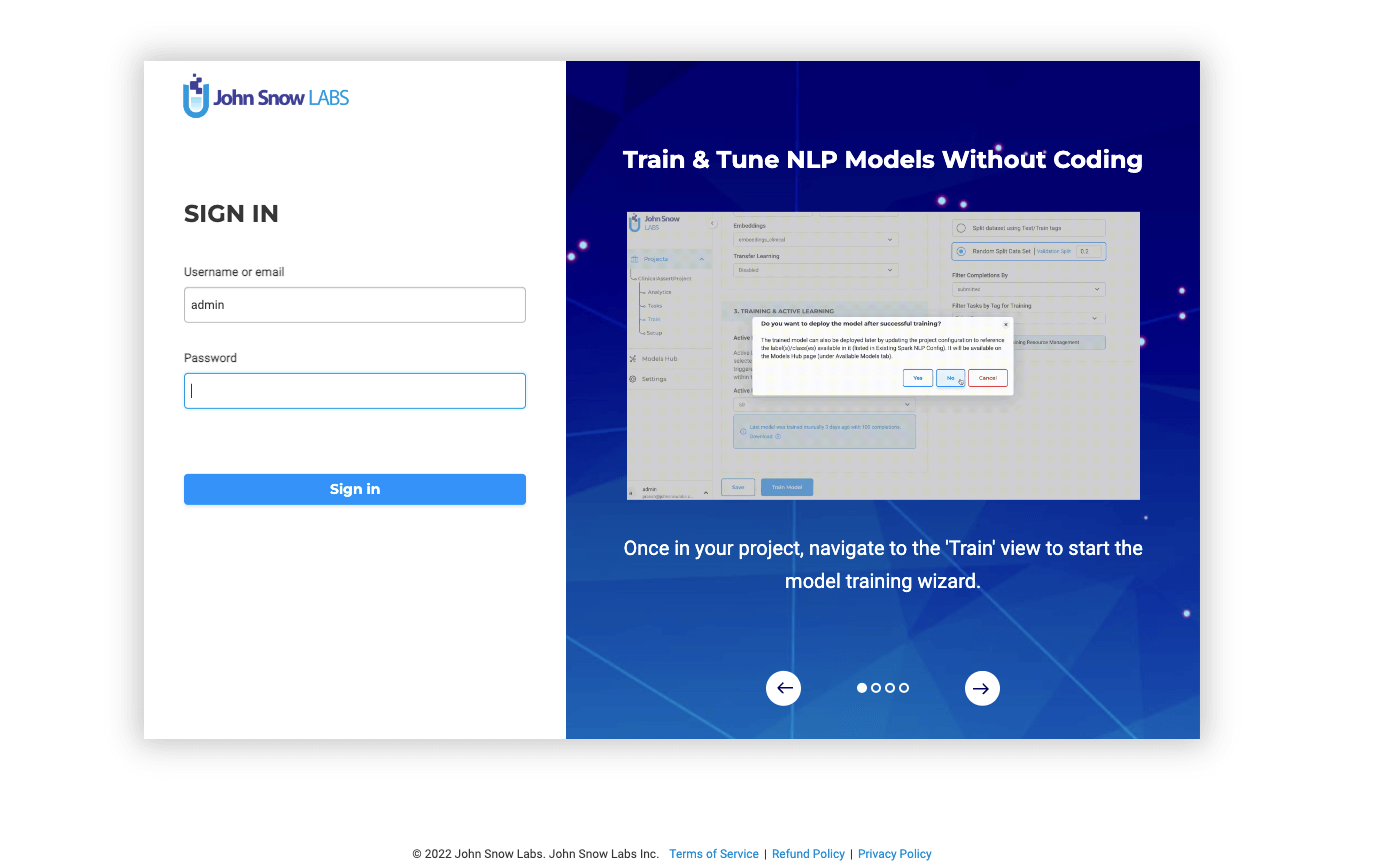
We have an aesthetically pleasing Sign-In Page with a section highlighting the key features of Generative AI Lab using animated GIFs.
AWS Marketplace
The Generative AI Lab needs to be installed on a virtual machine. One of the most straight forward method is an installation from AWS Marketplace (also available on Azure). The fee for the Generative AI Lab depends on the number of CPU and GPU in the selected instance (Details can be listed in the product page in AWS marketplace). You will also have to pay for the underlying AWS EC2 instance.
Visit the product page on AWS Marketplace and follow the instructions on the video below to subscribe and deploy.
Steps to get started:
- Subscribe to the product on the AWS Marketplace.
- Deploy it on a new machine.
-
In Launch an instance configuration attach IAM role to the AMI (IAM role attached to the AMI machine should have access to both
aws-marketplace:MeterUsageandec2:DescribeInstanceTypespermission)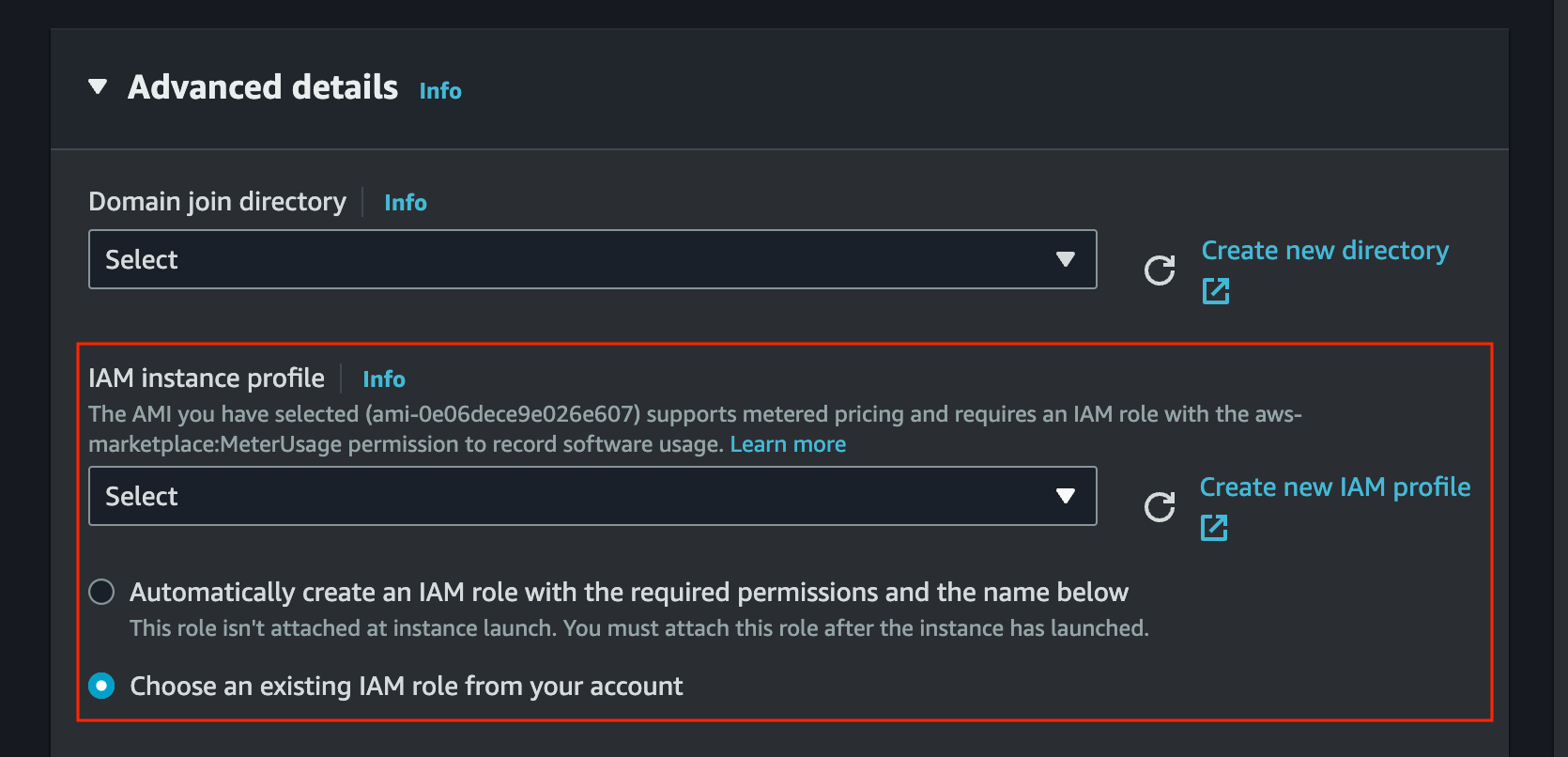
-
In advance details, enable
Metadata accessibleand selectV1 and V2inMetadata version
- Access the login page for a guided experience on
http://INSTANCE_IP. For the first login use the following credentials: Username: admin Password: INSTANCE_ID
Secure access to Generative AI Lab on AWS
When installed via the AWS Marketplace, Generative AI Lab has a private IP address and listens on an unsecured HTTP port. You can ask your DevOps department to incorporate the resource to your standard procedures to access from the internet in a secure manner. Alternatively, a Cloud Formation script is available that can be used to create a front end proxy (CloudFront, ELB, and auxiliary Lambda Function). Those resources are Free Tier Eligible.
Create the AWS Cloud Formation Script in YAML format:
vi cloudformation_https.yaml
AWSTemplateFormatVersion: '2010-09-09'
Metadata:
License: Apache-2.0
Description: 'AWS CloudFormation To access Generative AI Lab via https:
Create an Amazon EC2 instance running the Generative AI Lab Amazon Linux AMI. Once the
Generative AI Lab instance is created, provide instance hostname as input. This Cloudfromation
Creates Cloudfront. You can use Cloudfront Domain URL to access Generative AI Lab
via https protocol.
'
Parameters:
NLPlabInstanceHostName:
Description: HostName of the Generative AI Lab InstanceID
Type: String
ConstraintDescription: HostName of the Generative AI Lab InstanceID
Resources:
CloudFront:
Type: AWS::CloudFront::Distribution
Properties:
DistributionConfig:
Enabled: True
DefaultCacheBehavior:
AllowedMethods:
- DELETE
- GET
- HEAD
- OPTIONS
- PATCH
- POST
- PUT
DefaultTTL: 0
MaxTTL: 0
MinTTL: 0
Compress: True
ForwardedValues:
QueryString: true
Headers:
- '*'
Cookies:
Forward: all
TargetOriginId: EC2CustomOrigin
ViewerProtocolPolicy: redirect-to-https
Origins:
- DomainName: !Ref NLPlabInstanceHostName
Id: EC2CustomOrigin
CustomOriginConfig:
HTTPPort: '80'
OriginProtocolPolicy: http-only
Outputs:
CloudfrontURL:
Description: Cloudfront URL to access Generative AI Lab
Value: !Join ["", ['https://', !GetAtt [CloudFront, DomainName]]]
Click Create a stack, “Upload a template file”. Give the Stack a name and enter the Generative AI Lab instance Hostname(from the EC2 console) as a parameter.

Next -> Next -> Acknowledge that AWS CloudFormation might create IAM resources. -> Submit. Wait a few minutes until all resources are created.

Once created, go do the Outputs tab and click on the Generative AI Lab URL. You may need to refresh the view.

Now, to access the Generative AI Lab, you go to the CloudFront URL and log in with username “admin” and password equal to the EC2 Instance ID noted earlier.
Enabling SSL
Requirements:
- Fullchain certificate
- Private key used to sign the certificate
For ease of documenting the process we are going to use the following notations (please replace with your actual values in the process):
- fullchain.pem – name of the fullchain certificate file
- privkey.pem – key used to sign the certificate
- demo.example.com – the domain used for genailab app
For marketplace instance, the installer scripts files have to be downloaded (if installed with the the scripts, the files are already on the server and this step can be skipped):
wget -q https://s3.amazonaws.com/auxdata.johnsnowlabs.com/annotationlab/annotationlab-"$version".tar.gz
Extract the archive and copy fullchain.pem and privkey.pem into artifacts directory.
Create Kubernetes secret to be used by the ingress for SSL termination:
kubectl create secret tls demo.example.com --cert=fullchain.pem --key=privkey.pem
Edit the annotationlab-updater.sh in the same directory and add the following lines in the end of the script (helm command extra parameters):
--set ingress.enabled=true \
--set ingress.defaultBackend=false \
--set ingress.hosts[0].host='demo.example.com' \
--set ingress.hosts[0].path='/' \
--set ingress.tls[0].hosts[0]='demo.example.com' \
--set ingress.tls[0].secretName=demo.example.com
Note: If a self-signed certificate or any other type of internal certificates (not signed by any public CA) are used, an extra parameter is required for annotationlab-updater.sh:
--set ingress.sslVerify=false
After editing the script, run it to enable SSL:
bash -x annotationlab-updater.sh
Azure Marketplace
Visit the product page on Azure Marketplace and follow these steps. Generative AI Lab offers a one-click deployment within your security perimeter using Azure Kubernetes Service (AKS), a fully managed Kubernetes solution that simplifies the deployment, management, and scaling of containerized applications.
-
Click on the “Get It Now” link.
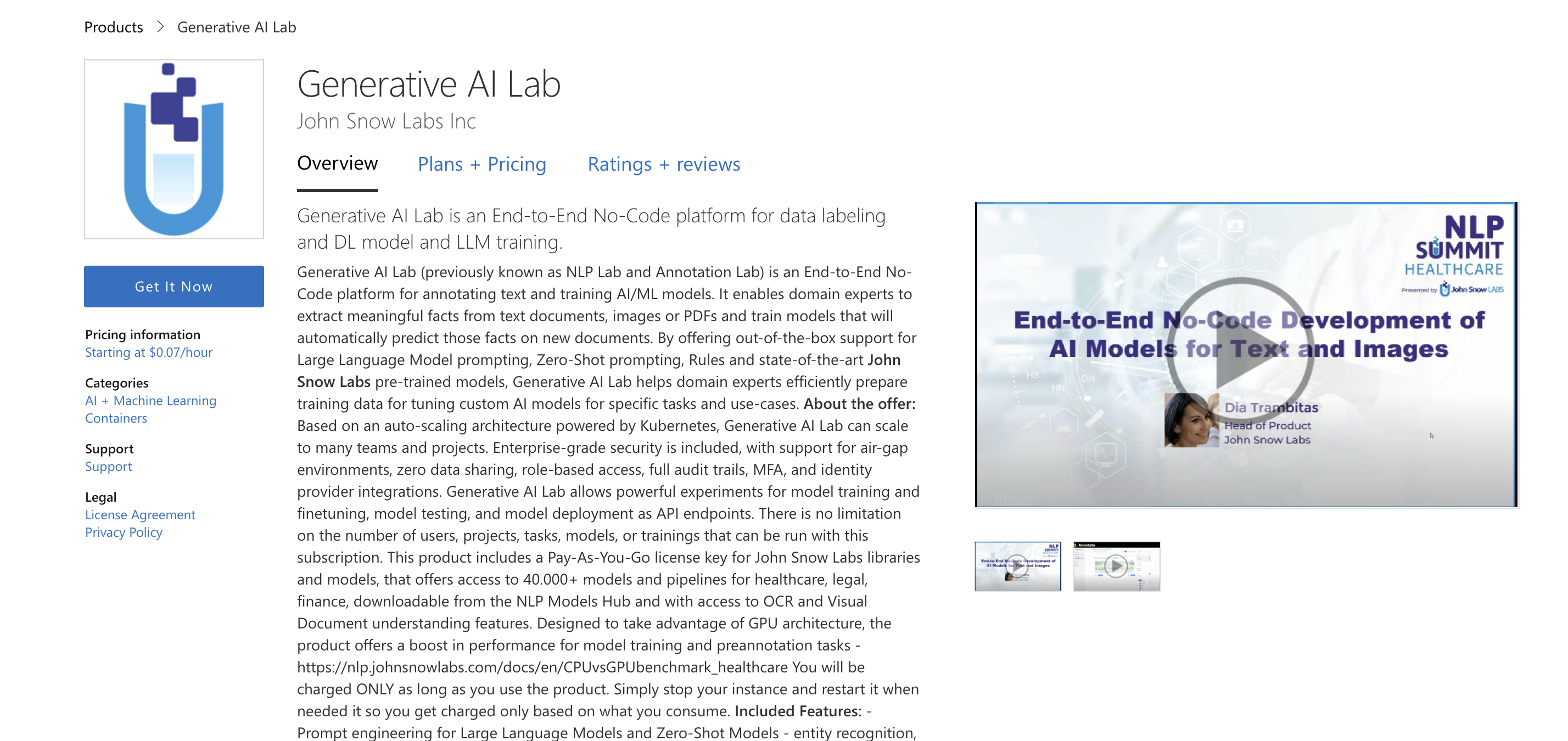
-
Select your subscription and the region where you want to deploy the cluster, then click “Next.”
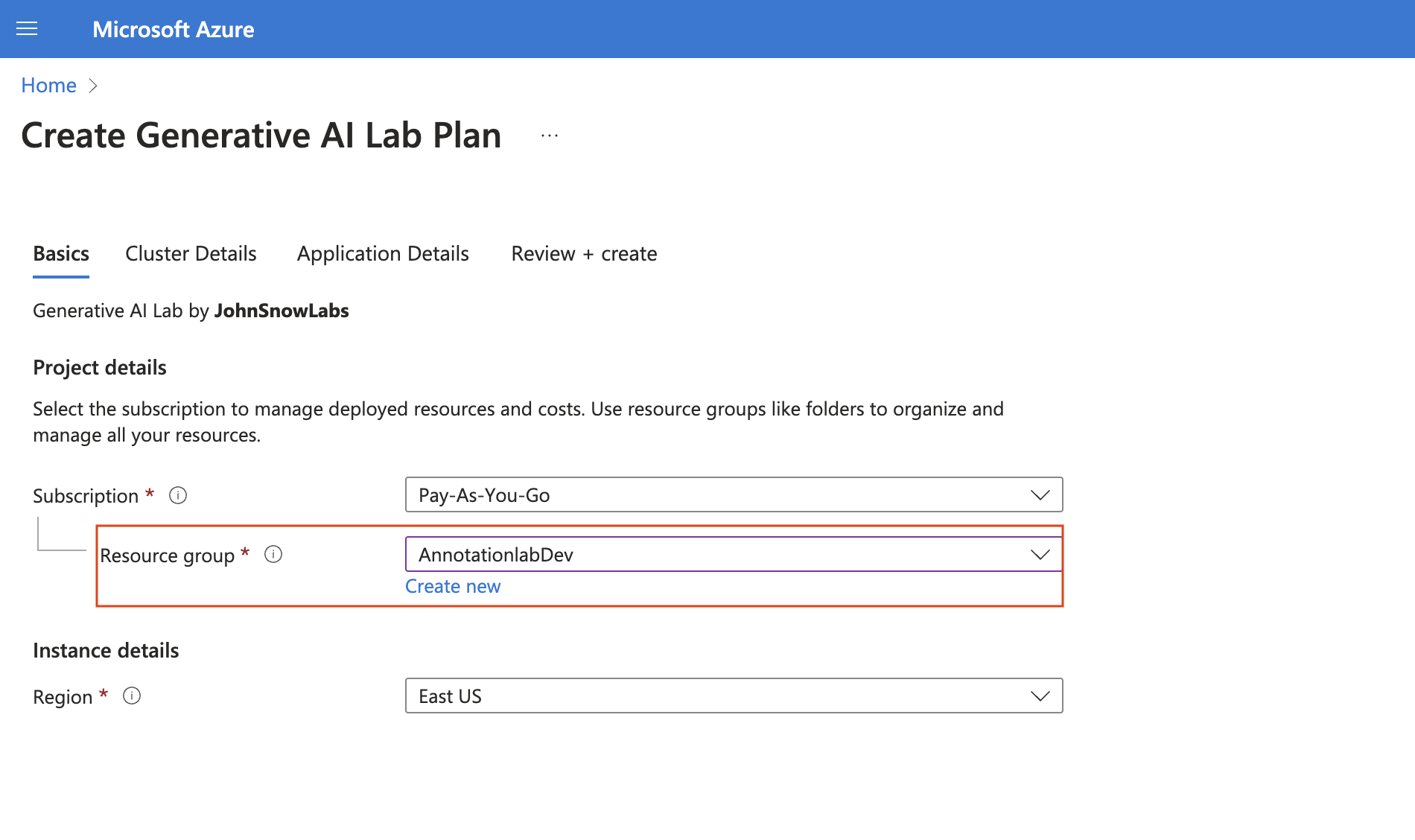
-
Choose the appropriate VM size and enable auto-scaling if you want nodes to be added automatically when needed. Then click “Next.”
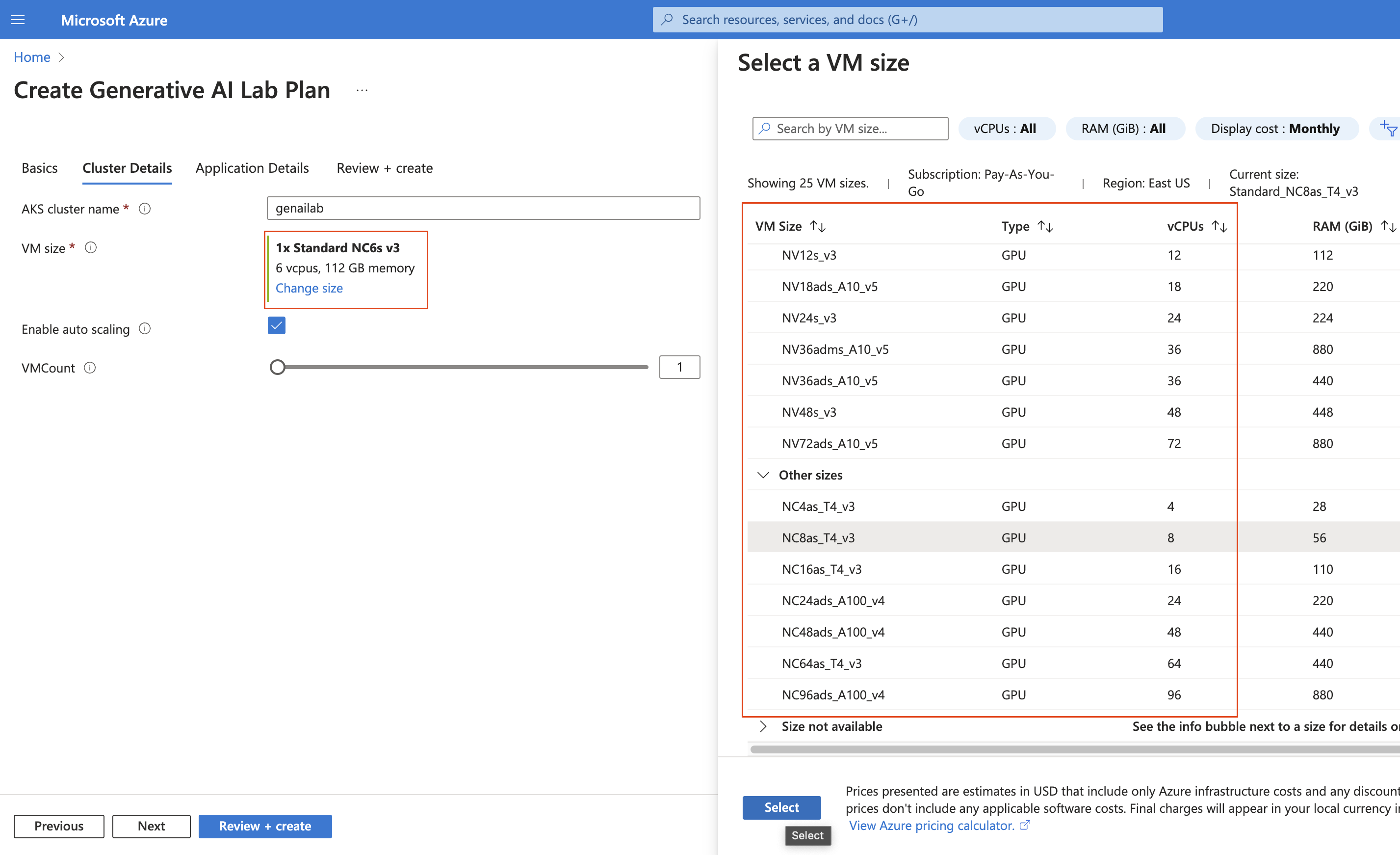
-
Provide the password (this will be used to access the Generative AI Lab UI with the admin user), then click “Next.”
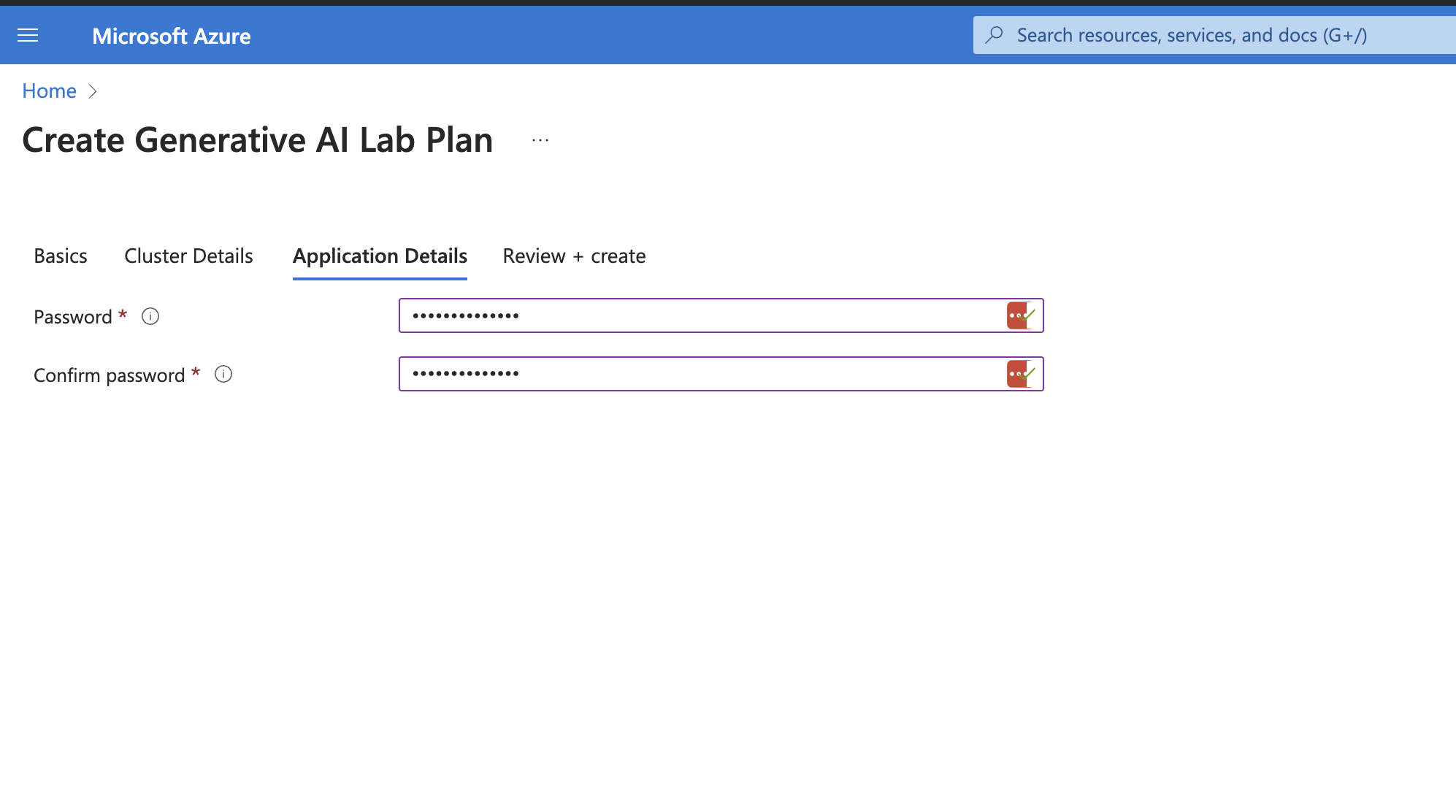
-
Review the configuration and then click “Create.”
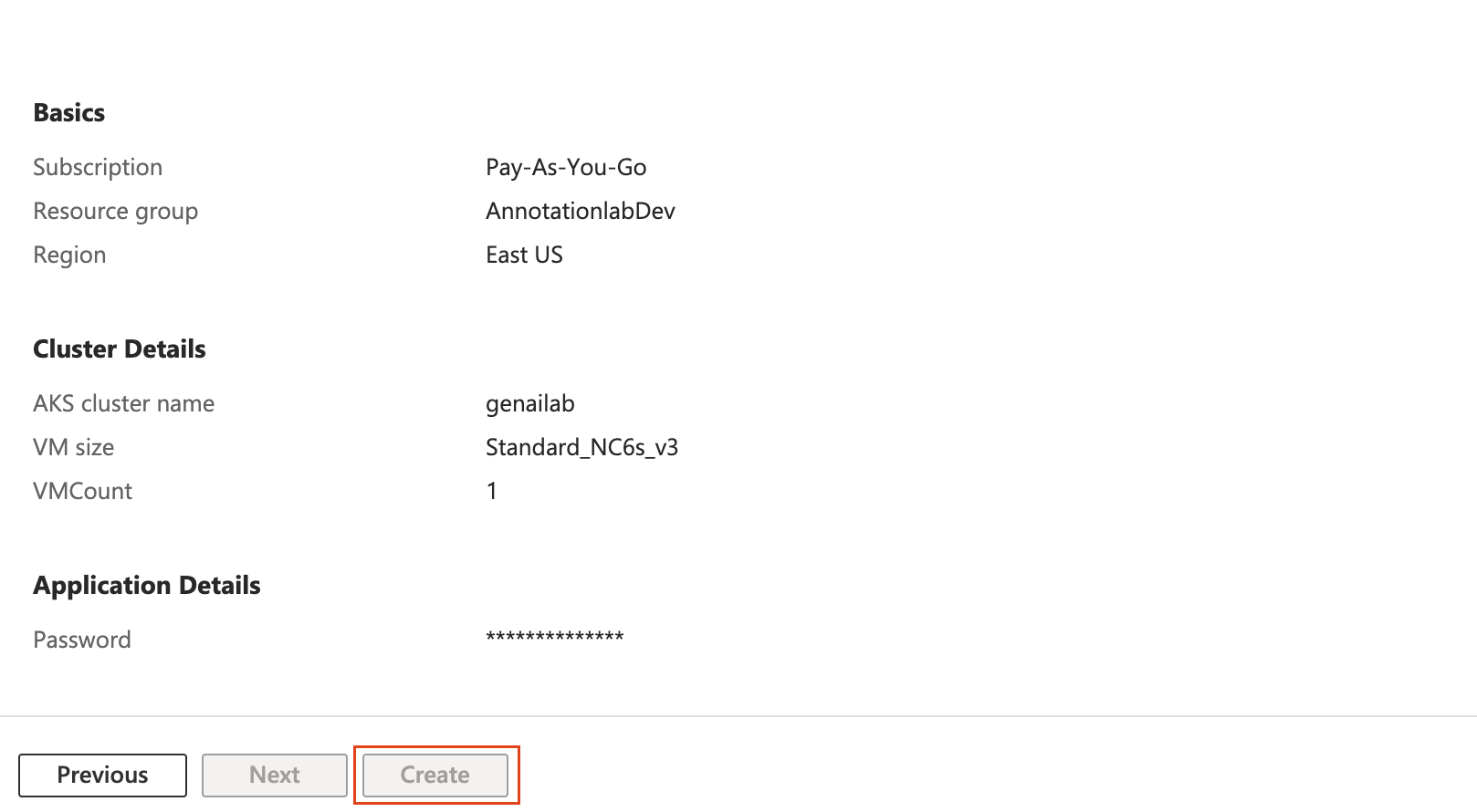
-
Visit the login page at http://External_IP for a guided experience. For your initial login, use the following credentials: Username: admin, Password: the password set in step 4.
Note: You can find the External_IP under Kubernetes resources by navigating to Services and ingresses and locating the addon-http-application-routing-nginx-ingress service name.
EKS deployment
-
Create NodeGroup for a given cluster
eksctl create nodegroup --config-file eks-nodegroup.yaml kind: ClusterConfig apiVersion: eksctl.io/v1alpha5 metadata: name: <cluster-name> region: <region> version: "1.21" availabilityZones: - <zone-1> - <zone-2> vpc: id: "<vpc-id>" subnets: private: us-east-1d: id: "<subnet-id" us-east-1f: id: "<subent-id>" securityGroup: "<security-group>" iam: withOIDC: true managedNodeGroups: - name: alab-workers instanceType: m5.large desiredCapacity: 3 VolumeSize: 50 VolumeType: gp2 privateNetworking: true ssh: publicKeyPath: <path/to/id_rsa_pub>eksctl utils associate-iam-oidc-provider --region=us-east-1 --cluster=<cluster-name> --approve -
Create an EFS as shared storage. EFS stands for Elastic File System and is a scalable storage solution that can be used for general purpose workloads.
curl -S https://raw.githubusercontent.com/kubernetes-sigs/aws-efs-csi-driver/v1.2.0/docs/iam-policy-example.json -o iam-policy.json aws iam create-policy \ --policy-name EFSCSIControllerIAMPolicy \ --policy-document file://iam-policy.jsoneksctl create iamserviceaccount \ --cluster=<cluster> \ --region <AWS Region> \ --namespace=kube-system \ --name=efs-csi-controller-sa \ --override-existing-serviceaccounts \ --attach-policy-arn=arn:aws:iam::<AWS account ID>:policy/EFSCSIControllerIAMPolicy \ --approvehelm repo add aws-efs-csi-driver https://kubernetes-sigs.github.io/aws-efs-csi-driverhelm repo updatehelm upgrade -i aws-efs-csi-driver aws-efs-csi-driver/aws-efs-csi-driver \ --namespace kube-system \ --set image.repository=602401143452.dkr.ecr.us-east-1.amazonaws.com/eks/aws-efs-csi-driver \ --set controller.serviceAccount.create=false \ --set controller.serviceAccount.name=efs-csi-controller-sa -
Create storageClass.yaml
cat <<EOF > storageClass.yaml kind: StorageClass apiVersion: storage.k8s.io/v1 metadata: name: efs-sc provisioner: efs.csi.aws.com parameters: provisioningMode: efs-ap fileSystemId: <EFS file system ID> directoryPerms: "700" EOFkubectl apply -f storageClass.yamlEdit annotationlab-installer.sh inside artifact folder as follows:
helm install annotationlab annotationlab-${ANNOTATIONLAB_VERSION}.tgz \ --set image.tag=${ANNOTATIONLAB_VERSION} \ --set model_server.count=1 \ --set ingress.enabled=true \ --set networkPolicy.enabled=true \ --set networkPolicy.enabled=true --set extraNetworkPolicies='- namespaceSelector: matchLabels: kubernetes.io/metadata.name: kube-system podSelector: matchLabels: app.kubernetes.io/name: traefik app.kubernetes.io/instance: traefik' \ --set keycloak.postgresql.networkPolicy.enabled=true \ --set sharedData.storageClass=efs-sc \ --set airflow.postgresql.networkPolicy.enabled=true \ --set postgresql.networkPolicy.enabled=true \ --set airflow.networkPolicies.enabled=true \ --set ingress.defaultBackend=true \ --set ingress.uploadLimitInMegabytes=16 \ --set 'ingress.hosts[0].host=domain.tld' \ --set airflow.model_server.count=1 \ --set airflow.redis.password=$(bash -c "echo ${password_gen_string}") \ --set configuration.FLASK_SECRET_KEY=$(bash -c "echo ${password_gen_string}") \ --set configuration.KEYCLOAK_CLIENT_SECRET_KEY=$(bash -c "echo ${uuid_gen_string}") \ --set postgresql.postgresqlPassword=$(bash -c "echo ${password_gen_string}") \ --set keycloak.postgresql.postgresqlPassword=$(bash -c "echo ${password_gen_string}") \ --set keycloak.secrets.admincreds.stringData.user=admin \ --set keycloak.secrets.admincreds.stringData.password=$(bash -c "echo ${password_gen_string}") -
Run annotationlab-installer.sh script
./artifacts/annotationlab-installer.sh -
Install ingress Controller
helm repo add nginx-stable https://helm.nginx.com/stable helm repo update helm install my-release nginx-stable/nginx-ingress -
Apply ingress.yaml
cat <<EOF > ingress.yaml apiVersion: networking.k8s.io/v1 kind: Ingress metadata: annotations: kubernetes.io/ingress.class: nginx meta.helm.sh/release-name: annotationlab meta.helm.sh/release-namespace: default name: annotationlab spec: defaultBackend: service: name: annotationlab port: name: http rules: - host: domain.tld http: paths: - backend: service: name: annotationlab port: name: http path: / pathType: ImplementationSpecific - backend: service: name: annotationlab-keyclo-http port: name: http path: /auth pathType: ImplementationSpecific EOFkubectl apply -f ingress.yaml
Migration from NLP Lab to Generative AI Lab
At the end of 2024, NLP Lab will officially retire, and no longer be available. We advise anyone wishing to continue using this tool to migrate to Generative AI Lab.
For on-premise deployments, please contact us for the newest artifacts.
For all Cloud deployments, please purchase and Install Generative AI Lab on a new server before migration, and then follow the steps below:
Steps to Backup Data from NLP Lab
- Login to your current NLP Lab deployment as the admin user.
- Go to the
System Settingspage. - Navigate to the
Backuptab. - Enter the required backup details.
- Schedule an immediate backup using the
Backup nowfeature. - Monitor the backup pod status to ensure the process completes successfully.
kubectl get pods
Verify Backup: Upon completion, your backed-up database and files will be visible in cloud storage.
Steps to Restore Data
- Deploy a fresh instance of Generative AI Lab version 6.8.0 or higher from the marketplace.
- Login to the UI as the admin user.
- Go to the
System Settingspage. - Click on the
Restoretab and fill in the necessary details. - Click on
Restore Nowto initiate the process. - Monitor the restore pod status to ensure successful completion.
kubectl get pods
Verify Restoration: Access the UI, all projects, models, data and files should now be successfully restored.
AKS deployment
To deploy Generative AI Lab on Azure Kubernetes Service (AKS) a Kubernetes cluster needs to be created in Microsoft Azure.
-
Login to your Azure Portal and search for Kubernetes services.
-
On the
Kubernetes services page click on theCreatedropdown and selectCreate a Kubernetes cluster. -
On the
Create Kubernetes cluster page, select the resource group and provide the name you want to give to the cluster.
-
You can keep the rest of the fields to default values and click on
Review + create.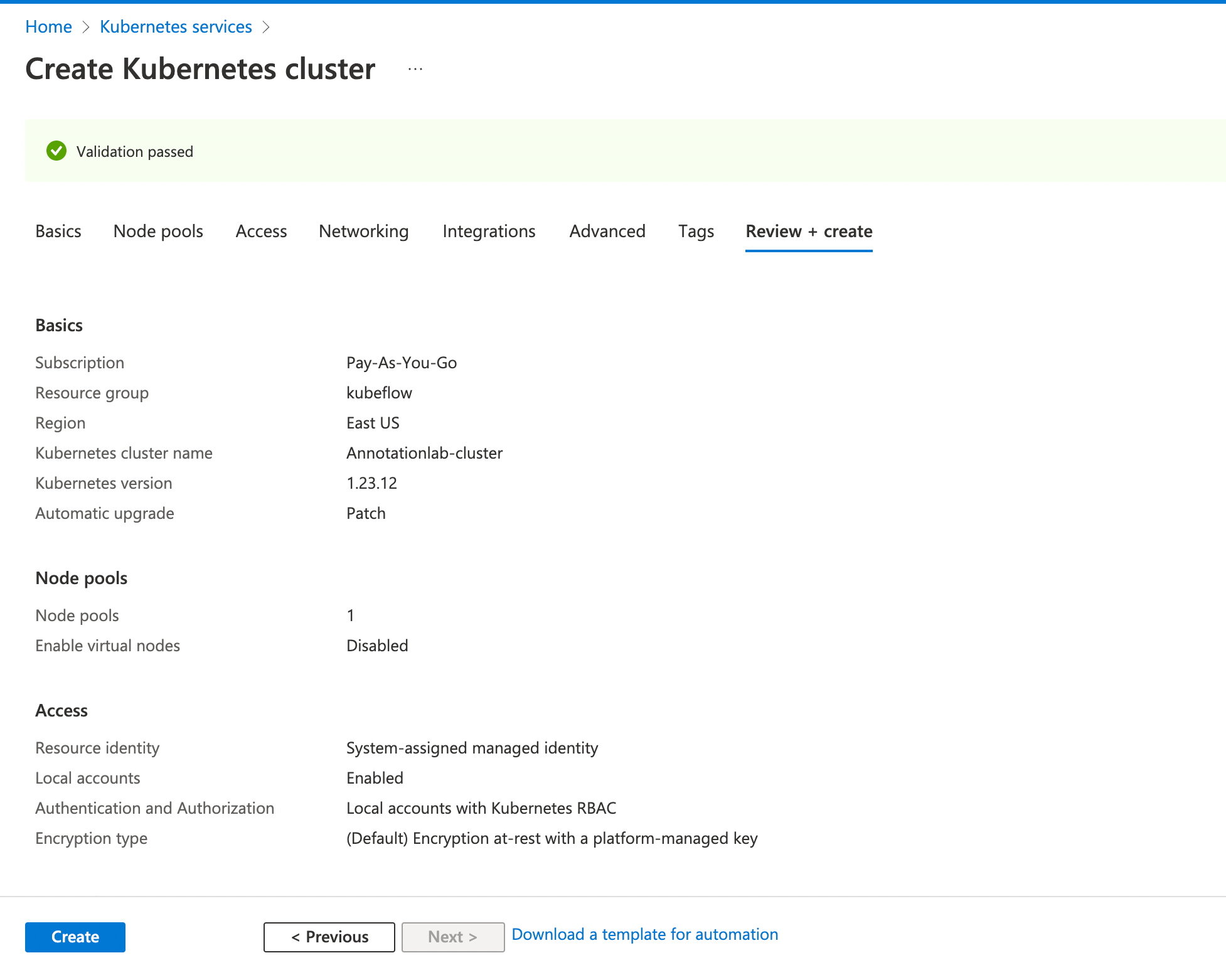
-
Click on
Createbutton to start the deployment process.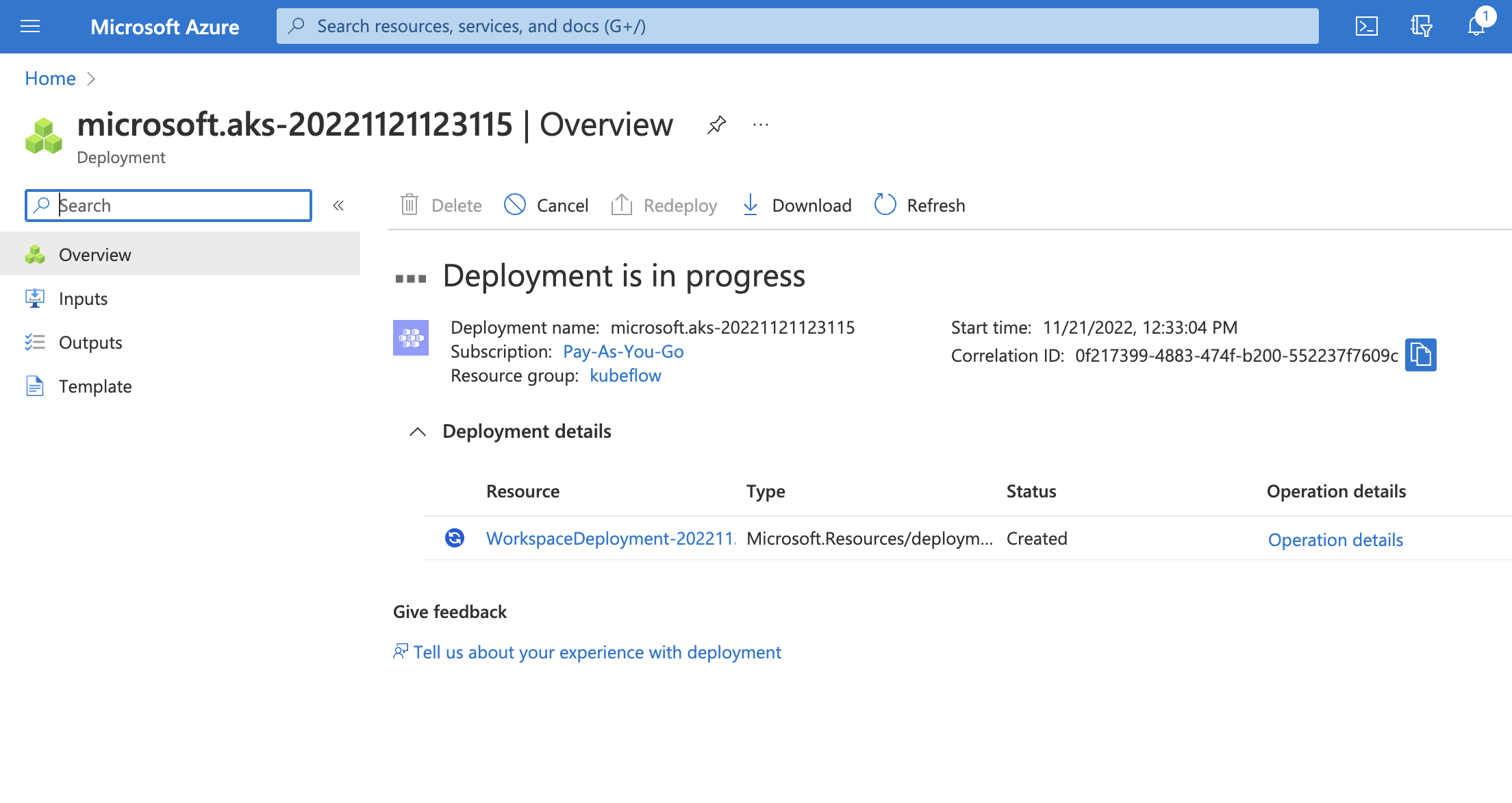
-
Once the deployment is completed, click on
Go to resourcebutton. -
On the newly created resource page, click on
Connectbutton. You will be shown a list of commands to run on theCloud ShellorAzure CLIto connect to this resource. We will execute them successively in the following steps. - Run the following commands to connect to Azure Kubernetes Service.
az account set --subscription <subscription-id>NOTE: Replace
with your account's subscription id. az aks get-credentials --resource-group <resource-group-name> --name <cluster-name>NOTE: Replace
and with what you selected in Step 3. -
Go to the artifact directory and from there edit the annotationlab-installer.sh script.
Comment or delete the following lines:
IMAGES="${ANNOTATIONLAB_VERSION} active-learning-${ANNOTATIONLAB_VERSION} dataflows-${ANNOTATIONLAB_VERSION} auth-theme-${ANNOTATIONLAB_VERSION} backup-${ANNOTATIONLAB_VERSION}" for image in $IMAGES; do crictl pull johnsnowlabs/annotationlab:${image}; doneReplace “helm install” command:
helm install annotationlab annotationlab-${ANNOTATIONLAB_VERSION}.tgz \ --set image.tag=${ANNOTATIONLAB_VERSION} \ --set ingress.enabled=true \ --set networkPolicy.enabled=true \ --set keycloak.postgresql.networkPolicy.enabled=true \ --set sharedData.storageClass=azurefile \ --set airflow.postgresql.networkPolicy.enabled=true \ --set postgresql.networkPolicy.enabled=true \ --set airflow.networkPolicies.enabled=true \ --set ingress.defaultBackend=true \ --set ingress.uploadLimitInMegabytes=16 \ --set airflow.redis.password=$(bash -c "echo ${password_gen_string}") \ --set configuration.FLASK_SECRET_KEY=$(bash -c "echo ${password_gen_string}") \ --set configuration.KEYCLOAK_CLIENT_SECRET_KEY=$(bash -c "echo ${uuid_gen_string}") \ --set postgresql.postgresqlPassword=$(bash -c "echo ${password_gen_string}") \ --set keycloak.postgresql.postgresqlPassword=$(bash -c "echo ${password_gen_string}") \ --set keycloak.secrets.admincreds.stringData.user=admin \ --set keycloak.secrets.admincreds.stringData.password=$(bash -c "echo ${password_gen_string}") -
Execute the annotationlab-installer.sh script to run the Generative AI Lab installation.
./annotationlab-installer.sh -
Verify if the installation was successful (all pods should be in Running state).
kubectl get pods
AirGap Environment
Get Artifact
Run the following command on a terminal to fetch the compressed artifact (tarball) of the Generative AI Lab.
wget https://s3.amazonaws.com/auxdata.johnsnowlabs.com/annotationlab/annotationlab-$VERSION.tar.gz
Extract the tarball and the change directory to the extracted folder (artifacts):
tar -xzf annotationlab-$VERSION.tar.gz
cd artifacts
Replace $VERSION with the version you want to download and install.
Fresh Install
Run the installer script annotationlab-installer.sh with sudo privileges.
$ sudo su
$ ./annotationlab-installer.sh
Upgrade
Run the upgrade script annotationlab-updater.sh with sudo privileges.
$ sudo su
$ ./annotationlab-updater.sh
Work over proxy
Custom CA certificate
You can provide a custom CA certificate chain to be included into the deployment. To do it add --set-file custom_cacert=./cachain.pem options to helm install/upgrade command inside annotationlab-installer.sh and annotationlab-updater.sh files.
cachain.pem must include a certificate in the following format:
-----BEGIN CERTIFICATE-----
....
-----END CERTIFICATE-----
Proxy env variables
You can provide a proxy to use for external communications. To do that add
`--set proxy.http=[protocol://]<host>[:port]`,
`--set proxy.https=[protocol://]<host>[:port]`,
`--set proxy.no=<comma-separated list of hosts/domains>`
commands inside annotationlab-installer.sh and annotationlab-updater.sh files.